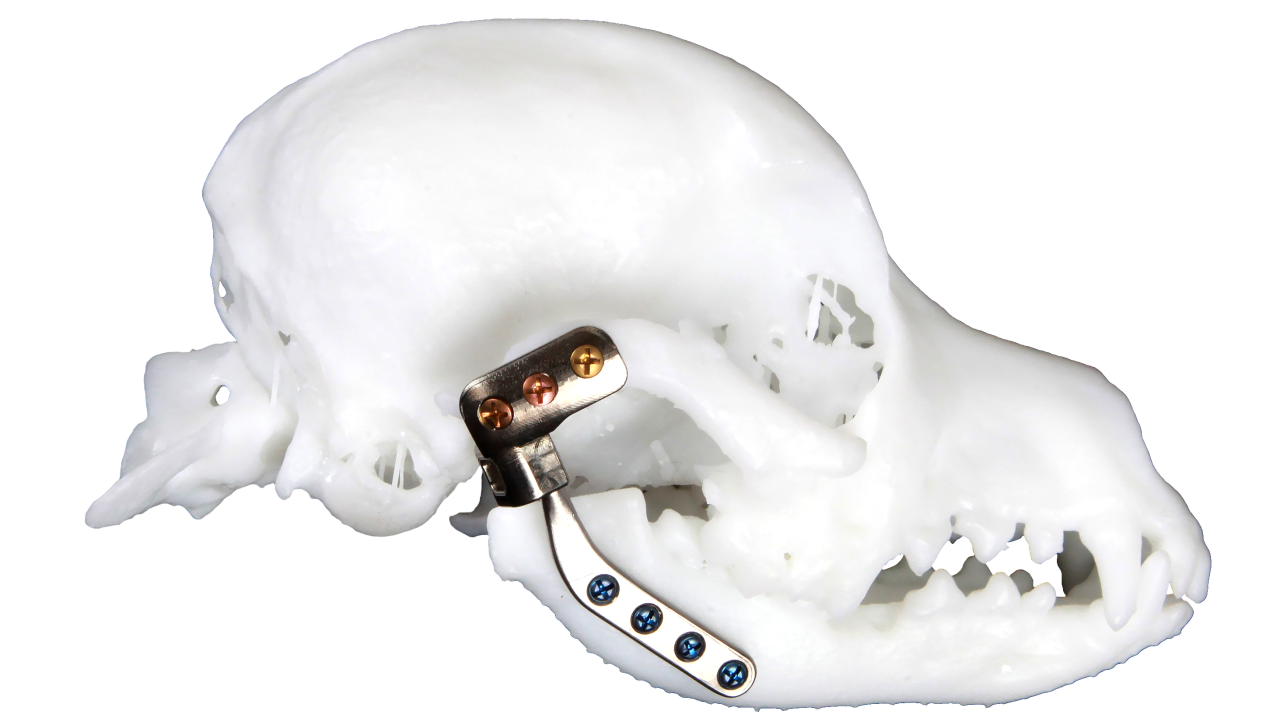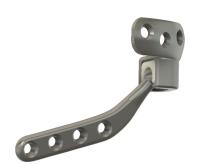
Patent Pending on UC Davis-Designed Temporomandibular Joint (TMJ) Prosthesis for Cats and Dogs

Veterinarians at the UC Davis School of Veterinary Medicine have gained patent pending status on a jaw joint replacement implant for cats and dogs with end-stage temporomandibular joint (TMJ) disorders. The group’s TMJ replacement (TMJR) prosthesis could revolutionize treatment for pets with non-functioning TMJs, either due to injury or disease. Initial research on the TMJR was recently published in the American Journal of Veterinary Research.
“About five years ago, I suggested the need for a TMJ replacement because we were seeing increased number of cats and dogs with fused jaws,” said Dr. Boaz Arzi, chief of the Dentistry and Oral Surgery Service (DOSS) at the UC Davis veterinary hospital. “The only recourse we have for these animals is to remove all the affected structures in the jaws to enable opening the mouth. While this allows the patient to eat and drink, there is no longer functionality to the joint, and their mouth can never close properly again.”
Dr. Arzi thought there had to be a better solution than this salvage procedure with the intention of improving functionality.
“Joint replacement in animals is well established in hips and strides are in place also for the knees and elbows,” Dr. Arzi stated. “Why not for the TMJ like in people with similar condition? Let’s create one!”
Dr. Arzi joined forces with Dr. Denis Marcelin-Little, a UC Davis veterinary orthopedic surgeon well versed in hip replacement and implant design and production, and Tanya Garcia, a biomedical engineer in the school’s J. D. Wheat Veterinary Orthopedic Research Laboratory. The trio created a TMJR implant loosely based on the FDA-approved TMJR used in humans, but designed with the needs of animals in mind.
An animal’s jaw only needs to move up and down, not additionally side to side or forward and backward like a human’s jaw. Dr. Arzi describes their invention as a hybrid of the human TMJR and a hip replacement implant.

To evaluate the mechanical properties of the joint, the team tested the TMJR on 16 cadavers of domestic cats (8) and medium to large breed dogs (8). Varying bite forces and other functions were applied to the implant to evaluate its behavior and capabilities. The TMJR resulted in joint motion not demonstrably different from the native TMJ, with the ability to fully open and close the mouth and with stability. This led the group to conclude that a novel TMJR may be implanted into patients and allow normal jaw motion.
As the team establishes a path to clinical use, their work continues to assess if the implant can sustain forces and not immediately fail or dislodge. They are currently testing “load to failure,” to determine the maximum force that the joint can withstand. Following that, “fatigue testing” will take place – a process that will open and close the joint 250,000 to 500,000 times to test its longevity.
The research was presented to the American Society of TMJ Surgeons, of which Dr. Arzi is the only veterinarian member, and was met with great enthusiasm.
“It was a good test of the implant’s feasibility,” stated Dr. Arzi. “Putting our work in front of the world’s best experts in this field, and getting good feedback, was very encouraging for the future viability of this product.”
The TMJR implant consists of a computer numerical control-milled plate affixed to the mandible with a neck and head that fits into a socket affixed to the skull. Initially, the implant will be created in universal sizes (S-M-L) to accommodate most dog and cat breeds, but the group is not ruling out custom-made implants in the future based on the specific needs of patients.
DOSS will soon begin evaluating suitable patients to be the first cases in a pre-clinical trial of the TMJR implant as a compassionate use model.
# # #
